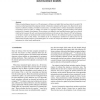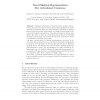137 search results - page 8 / 28 » A Framework for Modeling the Appearance of 3D Articulated Fi... |
CGF
2000
13 years 8 months ago
2000
When articulated figures interact in a 3D environment, collisions are highly likely and must often be avoided. We present a method automatically producing realistic collision-free...
TOG
2002
13 years 8 months ago
2002
We present a system for interactive shape and appearance editing of 3D point-sampled geometry. By generalizing conventional 2D pixel editors, our system supports a great variety o...
ECCV
2004
Springer
14 years 10 months ago
2004
Springer
Abstract. Volumetric structures are frequently used as shape descriptors for 3D data. The capture of such data is being facilitated by developments in multi-view video and range sc...
IPMI
1999
Springer
14 years 9 months ago
1999
Springer
The estimation of soft tissue deformation from 3D image sequences is an important problem in a number of fields such as diagnosis of heart disease and image guided surgery. In thi...
MICCAI
2009
Springer
14 years 6 months ago
2009
Springer
Automated segmentation of the esophagus in CT images is of high value to radiologists for oncological examinations of the mediastinum. It can serve as a guideline and prevent confu...


